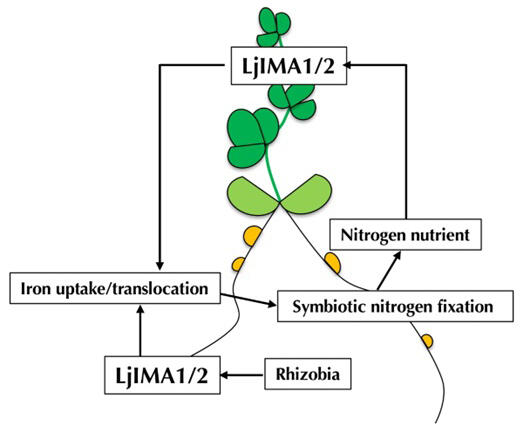A research group led by Associate Professor Takuya Suzaki of the Faculty of Life and Environmental Sciences at the University of Tsukuba, Professor Yoshikatsu Matsubayashi of the Graduate School of Science at Nagoya University and Assistant Professor Naoyuki Sotta of the Graduate School of Agricultural and Life Sciences at the University of Tokyo discovered that IRON MAN (IMA), a peptide factor in legume plants, regulates iron accumulation in rhizobial-colonized root nodules in response to the nitrogen status in the plant body. Functional analysis of the peptide was performed using Lotus japonicus, a model plant of the legume family.
The discovered peptide factor functions in Arabidopsis thaliana, which is not a legume and does not have root nodule (rhizobial) symbiosis. The factor is also responsible for nitrogen homeostasis in response to increased nitrogen in the plant body. The findings are expected to lead to the elucidation of the mechanisms of environmental adaptation in plants. The study results were published in the January 29 issue of the international academic journal Nature Communications.

Provided by the University of Tsukuba
To obtain nitrogen, which is essential for growth, legume plants live in symbiosis with rhizobia (nitrogen-fixing bacteria). Rhizobia fix nitrogen through the catalytic action of one of their enzymes, nitrogenase. This enzyme converts atmospheric nitrogen to ammonia in a form that can be used by plants. Although the enzyme was known to contain iron in its active center, it was unclear how iron is delivered to the rhizobia.
In this study, the research group used Lotus japonicus (a model plant in the legume family) to analyze gene expression changes in response to the nitrogen status in the plant body during the root nodule symbiosis process. Specifically, the gene expression changes in uninoculated plants and inoculated plants with or without functional nodules were compared. Additionally, the possible existence of a signaling factor that transmits the nitrogen status of the body to the roots was investigated.
Previous reports have shown that proteins of low molecular weight move between organs. Therefore, the research group searched for genes encoding low-molecular-weight proteins that are expressed in the above-ground parts of the plant in response to nitrogen status. As a result, an IMA peptide consisting of approximately 50 amino acid residues was found.
The IMA gene is expressed in the aboveground part of the plant in response to nitrogen fixation. The IMA peptide was previously reported in Arabidopsis thaliana, where it was found to be involved in the plant response to iron deficiency. Lotus japonicus possesses eight IMA peptides (LjIMA1 through LjIMA8), of which LjIMA1 and LjIMA2 are the two most highly expressed. To investigate the function of LjIMA1 and LjIMA2, knockout individuals without the genes of both peptides were generated.
The resultant LjIMA1/2-knockout plants showed abnormalities such as reduced root nodule size and an increased number of root nodules, confirming a decrease in nitrogen-fixing activity of the rhizobia.
To further investigate for which parts of the plant body the IMA peptides are important, grafting experiments were conducted. In the experiments, the aboveground parts and roots of wild-type (normal) plants were grafted onto those of LjIMA1/2-knockout plants. These peptides were found to be involved in the regulation of root nodule symbiosis in both the aboveground parts and roots.
The abnormalities in the knockout individuals are caused by their inability to accumulate iron in the root nodules. Thus, it is clear that these IMA peptides are responsible for iron collection in the root nodules of individual plants. These peptides were found to regulate the expression of genes coding for enzymes involved in iron transport. IMA peptides are widely conserved in Arabidopsis thaliana and other plants that do not have root nodule symbiosis.
The function of the IMA peptide was further clarified by knocking out its gene in Arabidopsis thaliana and Lotus japonicus, which resulted in a negative effect on plant growth owing to an inability to cope with increased nitrogen in the body. These results indicate that IMA peptides regulate the balance between nitrogen and iron levels in the body in a wide range of plant species, thereby maintaining nitrogen homeostasis and controlling environmental adaptation in plants.

Provided by the University of Tsukuba
Suzaki said, "If we can artificially synthesize peptides with functions like those revealed in this study, we may be able to use them as fertilizers that collect iron in the soil in nodules and promote plant growth. We would also like to further elucidate how these IMA peptides interact with iron and transport it to the rhizobia."
Journal Information
Publication: Nature Communications
Title: IMA peptides regulate root nodulation and nitrogen homeostasis by providing iron according to internal nitrogen status
DOI: 10.1038/s41467-024-44865-4
This article has been translated by JST with permission from The Science News Ltd. (https://sci-news.co.jp/). Unauthorized reproduction of the article and photographs is prohibited.




